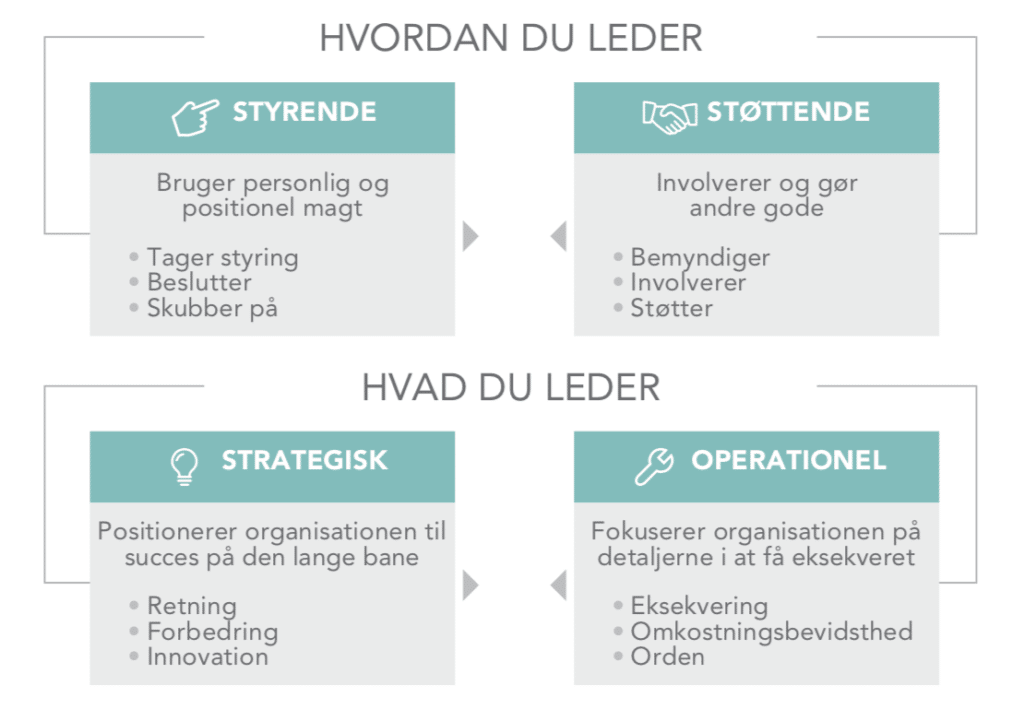Be the leader you need to be
Versatile leadership is about being able to interpret and react to change and then choose the right leadership behavior. It requires you to balance complementary leadership styles - and be the leader you need to be in a given situation.
Versatile leaders are more effective
The second step is to analyze the levels that make up the management chain. The purpose is to map the entire management chain, which could consist of the following levels: director, manager, department heads and unit managers. The task here is to determine whether the current organization is the organization you need in the future. Is there a need to organize the management chain in a different way, such as adding/reducing levels or perhaps aligning management levels across the organization? If the existing management organization does not support the realization of the organization's strategies and visions, you should work on redesigning the management organization.

Four opposing leadership styles you need to balance
To lead more versatile, you need to balance between four opposing leadership styles: directive leadership, supportive leadership, strategic leadership and operational leadership.

READ MORE ABOUT OUR EDUCATION
LEAD
offers certification in the development of agile leadership with the development tool The Leader's Versatility Index (LVI)
With a certification, you will be equipped to use LVI in development processes in your organization at the individual, group and organizational level.
The potential to do better is huge
We asked 11,000 superiors, subordinates and peers how effective their managers are when it comes to balancing directive and supportive leadership.
When it comes to trust and giving people room to grow, we're very high on the right dosage. But, in the shadow of that high level of trust, we struggle to give direct, developmental feedback and hold people accountable.
There is simply a lack of leadership "the good way". This may be due to the fact that we in Denmark have bought so heavily into trust, equality and recognition as leadership tools that we have a distorted, negative image of the complementary and profoundly necessary leadership.
The call for more feedback, more frequent follow-up, more stimulating and challenging tasks and more accountability for success comes from the 11,000 colleagues who have voiced their opinions.
They want this to feel more valued and more significant in their work life.
In other words, there is a huge, untapped recognition potential in developing the right relationship with the governing leadership styles to improve the Danish work environment and act more effectively in the leadership role.
Video: 59% of Danish managers give too little direct feedback, according to their employees. This is according to a large survey we conducted.
Three tips for working towards more versatile leadership:
- Know yourself
What are your leadership strengths and weaknesses. Be aware of your strengths - what are they and in what contexts are they actually a strength? - Be careful not to overstate your strengths
Many leaders have a tendency to overstate their strengths when they are under pressure or don't know how to understand the world around them - and it affects relationships and effectiveness. You need to know your strengths as a leader and use them. But be careful not to overplay them for lack of other options in your leadership repertoire. - Know your preferences and dislikes
Leaders are human beings driven by values and preferences, for better or worse, just like any other human being. Your preferences will keep you stuck in one behavioral pattern, supported by your dislikes that will keep you from the complementary behavioral pattern. If you want to develop versatile, agile and versatile leadership, you need to know your preferences and dislikes so you can reflectively apply the leadership styles that are outside your comfort zone because the task calls for it.




